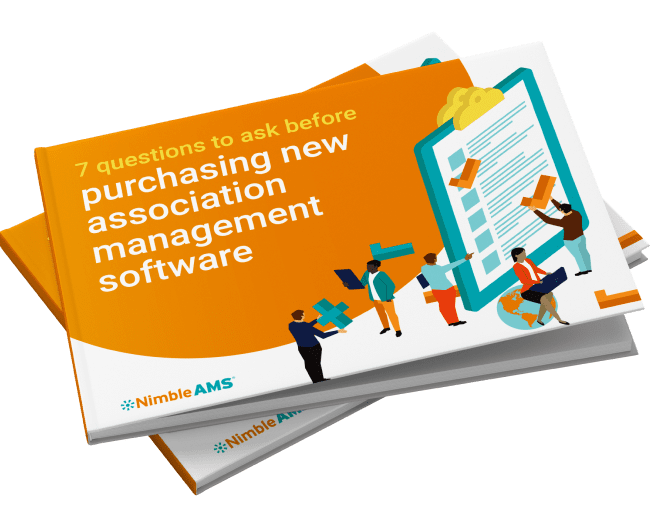Associations worldwide use association management software (AMS) to boost efficiency and enhance member experiences. The software can streamline manual processes and analyze member behavior to improve engagement levels. AMS providers constantly update the systems to feature the newest upgrades.
When you’re ready to move to a new AMS, you’ll likely issue a request for proposal (RFP). An RFP gathers software proposals and examines how well potential products meet your requirements and budget. An RFP assists greatly with big purchases like software, allowing you to find the best fit for your needs.
Keep reading to learn more about how to write an AMS RFP.
What is an RFP?
An RFP is a document that prepares you to implement a new AMS. When crafting the document, you provide background and details about your desired project. Once you submit the RFP, it solicits bids from vendors. It organizes vendor data in an accessible format so you can compare your options more easily.
An RFP offers an objective approach to AMS investments. By closely comparing your vendor options, you can minimize risk and make a more confident choice for your software investment. Using an RFP creates clear expectations and finds the AMS provider that best meets your association’s needs.
Some of the most important elements in an RFP include:
- Overview of your organization
- Project overview
- Project goals
- Requirements, including budget
- Deliverables and specifications
- Project timeline
- Proposal format/outline
- Request for references
- Proposal due date
- Your criteria for evaluating RFPs
- How to reply/contact information
Your organization can write the RFP, or depending on your staff bandwidth, you might choose to collaborate with a third-party consultant. Sometimes, the project can grow too complicated for in-house staff, and these professionals can guide you through the creation process. Working with a consultant ensures you’ll include all the necessary elements and use the proper formatting techniques.
Additionally, consultants understand current industry trends and can identify leading AMS options for your association. Working with these professionals can help your organization determine which software is best for your employees and members based on your budget, technological needs, and staff skills. You could even consider having the consultant play a role beyond the AMS selection – some of the most successful implementations have the selection consultant as part of the implementation team.
How to create an AMS RFP
A well-crafted RFP is important to the success of your AMS project. It conveys the project scope to software vendors, helping to ensure you get accurate proposals and choose the right AMS for your association. It’s crucial to create a clear and correctly formatted document so vendors fully understand your requirements. In turn, you can receive the highest number of quality responses to choose from.
Here are five steps for creating an AMS RFP:
1. Do your homework
There are dozens of AMS vendors in the marketplace. With so many to choose from, you need to do some preliminary work to identify your key requirements.
Here are four key factors to consider when preparing for your new AMS:
- Outline your biggest challenges. If you need to upgrade to a new AMS, this likely means your current system failed to meet some of your needs. As you start the search for a new AMS, consider what requirements it must meet. Identify your association’s biggest challenges and use these to frame your search. For example, your association might be overloaded with manual work, so you want to find an AMS that automates procedures.
- Determine access levels. Next, find out which functional areas of the organization will need to access the new AMS. Determining regular usage can also help you decide between vendor options.
- Select your core team. You should also identify your selection team early in the process. You should include your association’s shareholders, leadership officials, and other important members. Once you have a team in place, you can work together to create the document and examine your vendor options.
- Determine timelines. It’s essential to identify basic timelines and high-level budgets for the project. A rough schedule helps you stay on track financially during the project, allowing you to meet your goals sooner.
2. Send an RFI first
The next step for many associations is to send a request for information (RFI) before the RFP. The RFI can narrow your list of prospective AMS vendors. The document asks basic questions, such as:
- What are your high-level capabilities?
- What strengths does your software offer?
- How much does the software typically cost?
You can work with your stakeholders and selection team to create this document. It is fair to send an AMS request for information to many prospective AMS vendors. You can use these responses to narrow your list of options before sending out your RFP.
3. Create your RFP
Once you have a shortened list of providers in hand, it’s time to write your RFP. If you’re unsure where to start, consider enlisting a consultant or other experienced professional to help.
These are the basic components of what to include in an AMS RFP:
- Introduction and brief background. Begin your document by giving a brief background into your association. This information allows vendors to understand your industry and its current trends. It also helps them understand your business goals, showing how well a partnership would work.
- Description of services. Next, provide a detailed description of the services you require. List and explain the software features you need. For instance, you could describe your need for automation software, AI and predictive analytics, or integration capabilities.
- Selective criteria and timelines. Lastly, outline your intended timeline for implementation and other selection criteria. Vendors can gauge whether they can meet these requirements, allowing both of you to find the best fit.
4. Send the RFP to no more than three vendors
After you’ve completed your RFP, it’s time to send it out. Use the RFI to narrow the list of prospective vendors to three or fewer. Sending to more than three vendors indicates that you have not done your homework and will dramatically reduce the quantity and quality of responses. In fact, many top–tier vendors likely will not respond if the number is greater than three.
5. Set a realistic time frame for RFP responses
Allow enough time for the vendors to provide you with high-quality responses. It’s unrealistic to send a 50-page or longer RFP and expect a response within two weeks. Instead, allow four to six weeks for a thorough, well-considered response. And be ready for vendors’ questions during this time frame.
Sample timeline for an RFP
A detailed timeline can help you and potential vendors better understand your project’s scope.
This is an example of an AMS RFP timeline you might implement for an RFP:
- Day 1-10: Identify your business needs and requirements for the new AMS software.
- Day 11-15: Write your RFP with your team.
- Day 16: Send your RFP to three vendors.
- Day 45: Set the RFP deadline for responses at 45 days.
- Day 45-55: Evaluate proposals and vendors.
- Day 56-65: Contact your selected vendor and negotiate the terms of your contract.
Your timeline should meet your current needs. You can adapt the timeline to suit your specific time frames. For instance, if you estimate that writing the RFP will take longer, you can adjust accordingly.
How to Conduct Vendor Research
An AMS request for proposal is all about potential vendors. The first step of your project is vendor research, and it’s important to use strong research strategies. During this step, you’ll look at all available provider options and start to narrow them down to meet your needs.
Here are some tips for conducting vendor research:
- Examine market trends. One of the best places to start is with initial market research. Current trends can inform you of the best decision. Look for any leading providers on the market and research if they would fit your association’s requirements.
- Work with a consultant. As mentioned, professional consultants can assist with the vendor research process. Consultants understand current trends in your industry and can identify leading AMS options. They can also evaluate your association’s requirements and find providers that meet your needs.
- Use an RFI. Lastly, an AMS RFI can help you complete your vendor research. Communicating directly with potential vendors can help you get a sense of their services and personalities. You can also discern whether their installation times and product features meet your needs.
What factors cause vendors to decline an RFP?
You might follow all the necessary steps but not receive any responses from vendors. A lack of responses can be frustrating, but it’s important to understand the reasoning so you can prevent it from occurring again.
These are some red flags that can cause a vendor to decline to respond:
- Poorly written RFP
- Lack of clarity of goals and objectives
- Lack of transparency
- Lack of timely responses
- Disengaged or difficult interactions with staff
Examine your submitted RFP and determine whether any of these factors might have caused a vendor not to respond. In the future, you can seek the help of consultants to assist with the creation process.




